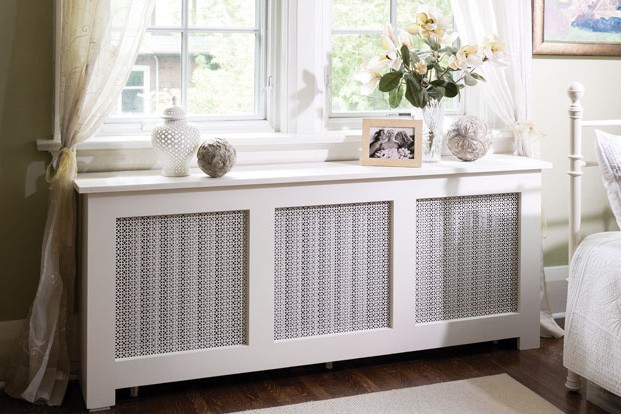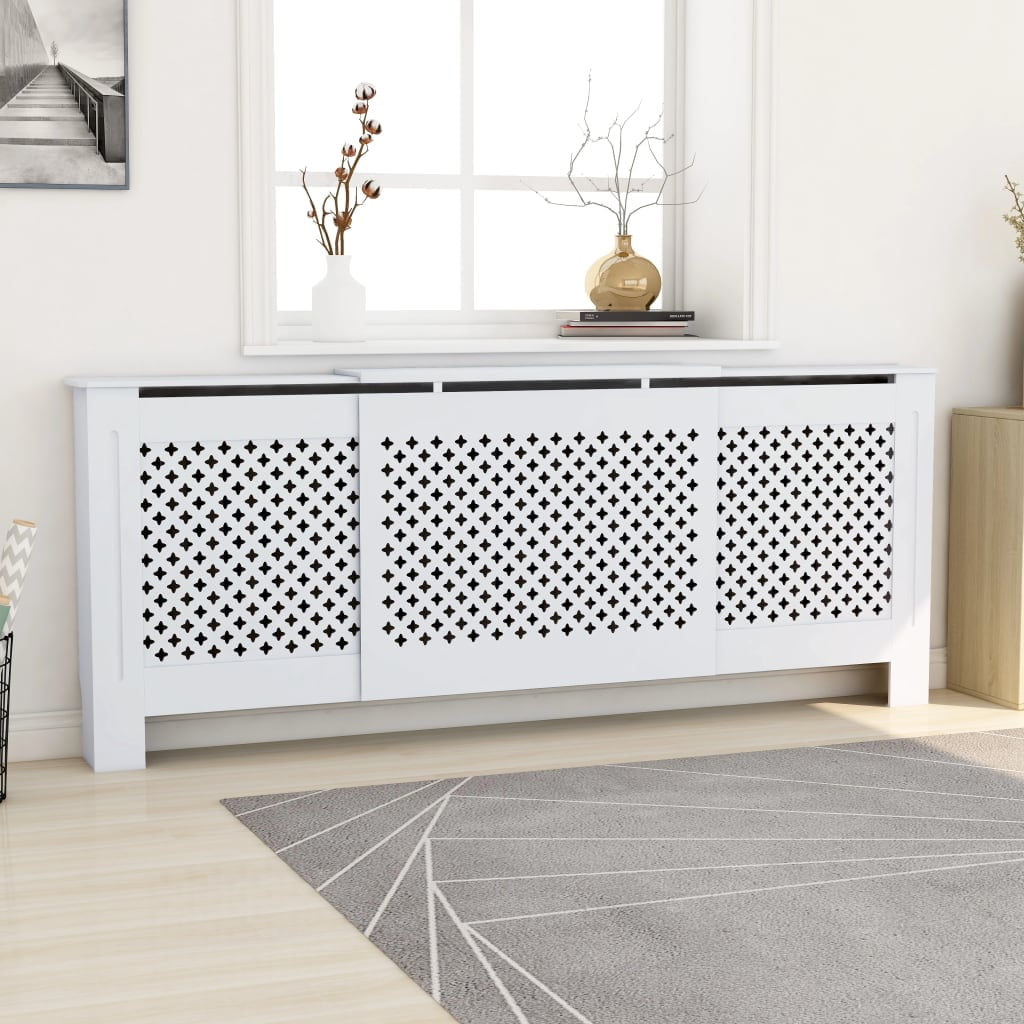A Step-by-Step Checklist for Measuring Custom Radiator Covers Correctly
A Step-by-Step Checklist for Measuring Custom Radiator Covers Correctly
Blog Article
Key Functions to Take Into Consideration When Selecting Custom Radiator Covers for Your Space
Picking custom-made radiator covers involves numerous vital elements. Product toughness is vital for durability, while style needs to integrate with the existing decoration. Size fit is key for functionality and aesthetic appeals. Furthermore, considerations around warm performance and air flow can impact performance. Nevertheless, the subtleties of setup and upkeep commonly stay neglected. Recognizing these aspects will lead you towards an informed decision that enhances your space effortlessly. What other elements should be thought about?

Material Options for Custom-made Radiator Covers
When choosing custom-made radiator covers, the choice of materials plays a crucial role in both aesthetic appeals and functionality. Numerous products are readily available, each with special properties that cater to various needs. Wood, for instance, offers a timeless look and can be quickly customized, however it may be prone to buckling in high humidity. Metal options, such as light weight aluminum or steel, offer toughness and warmth resistance, making them suitable for high-heat environments. custom radiator covers.For those seeking a contemporary touch, MDF (medium-density fiberboard) is a prominent selection; it can be repainted or ended up to match any type of decoration while continuing to be economical. Furthermore, some may choose acrylic, which enables for creative layouts and transparency, although it may not be as heat-resistant. Eventually, the choice of material greatly influences not just the cover's look yet also its longevity and performance in efficiently taking care of warmth result
Style Designs to Suit Your Home Design
Although radiator covers serve a useful objective, their layout can greatly enhance the general aesthetic of an area. House owners can select from various designs to seamlessly incorporate these covers right into their existing design. For a contemporary appearance, streamlined metal or minimal wooden styles supply a clean, modern vibe. On the other hand, traditional homes might profit from luxuriant wood covers with detailed makings that mirror timeless craftsmanship.Farmhouse styles often incorporate rustic aspects, utilizing redeemed timber for a cozy, inviting touch. For those who favor an eclectic strategy, strong shades and patterns can be utilized to develop a declaration piece that attracts the eye.Additionally, including open styles or decorative grilles can enable air movement while adding aesthetic passion. Choosing a design that matches the general theme of the home warranties that the radiator cover comes to be not simply a functional component but also a stylish focal factor within the space.
Dimension and Fit Considerations
How can homeowners guarantee their customized radiator covers fit completely within their areas? Precise dimensions are necessary for achieving a seamless fit. Homeowners must begin by gauging the size, width, and height of their radiators, considering any type of sticking out elements such as pipes or shutoffs. In addition, it is crucial to consider the surrounding space, making sure that the cover does not block air flow or disrupt furnishings placement.Choosing the ideal material and design can also influence fit; as an example, some products may require particular densities to assure toughness. Home owners ought to additionally assume about the desired style of the area, ensuring that the cover complements existing style while suitable conveniently in the marked location. A well-measured and thoughtfully created cover not just enhances visual appeals however additionally ensures reliable home heating by allowing proper ventilation around the radiator.
Setup Refine and Needs
To assure an effective installment of custom-made radiator covers, mindful preparation and focus to detail are crucial. Initially, one need to properly measure the radiator measurements and bordering area to validate an appropriate fit. Next off, selecting the ideal products is necessary; alternatives might consist of timber, steel, or composite materials, each requiring particular tools and techniques for installation.Before starting the installation, it is recommended to collect all required tools, such as braces, screwdrivers, and drills, to enhance the process. The setup area ought to be free from obstacles for safety and security and efficiency.Once ready, the customized covers can be firmly installed, making sure that they are leveled and aligned properly. Adhering to producer guidelines throughout this phase is imperative to prevent any type of structural concerns. An extensive assessment should be carried out to validate that the covers are securely affixed and visually appealing, contributing to the overall visual of the room.
Heat Effectiveness and Air Movement
When selecting custom-made radiator covers, warmth performance and air flow are critical elements to contemplate. Proper ventilation design assurances excellent heat circulation throughout a room, stopping cool places and making best use of convenience. Interest to these elements can greatly improve the total performance of a heating system.
Ideal Warm Distribution
Suitable warm distribution is essential for keeping a comfy interior setting, and custom radiator covers can substantially boost this procedure. custom radiator covers. These covers are made not just for aesthetics but likewise to enhance heat efficiency. By routing cozy air properly throughout the room, they prevent chilly places and ensure that heat circulates uniformly. Correctly designed covers can help with air movement while minimizing obstruction, allowing warm air to rise and disperse normally. Furthermore, the materials made use of in customized radiator covers can affect heat retention and result. Picking covers that stabilize style and functionality is essential, as they can add significantly to a home's general heating performance, improving comfort and potentially reducing energy expenses over time
Air Flow Design Factors To Consider
Efficient ventilation design is essential for making certain optimal heat effectiveness and airflow in areas with radiator covers. When selecting a customized cover, it is vital to think about features that promote unblocked air activity. Grilles and vents need to be purposefully put to permit warm air to distribute openly while preventing getting too hot. Furthermore, the product of the cover can affect airflow; light-weight products commonly promote much better air flow contrasted to much heavier alternatives. The style must additionally represent maintaining excellent distances between the cover and radiator to enhance efficiency. Inevitably, a well-designed radiator cover will not only boost the aesthetic appeal of a room but likewise add to reliable home heating, producing an extra comfy environment.
Modification and Personalization Attributes

Upkeep and Treatment Tips for Durability
Maintaining custom radiator covers is necessary for their long life and look. Regular cleaning practices, the use of ideal cleaning solutions, and seasonal inspections can significantly boost their resilience. Implementing these treatment suggestions guarantees that the covers remain functional and aesthetically appealing gradually.
Regular Cleaning Practices
Regularly dusting custom radiator covers is important for maintaining their appearance and capability. Dirt accumulation can obstruct air flow, possibly affecting the radiator's efficiency. It is advisable to carry out a regular cleaning routine, preferably when a week, more helpful hints to stop accumulation. A soft microfiber towel or a duster is suggested for this job, as these materials successfully catch dirt without scratching the surface. Treatment must be required to clean the areas surrounding the radiator cover also, making certain that no dirt is delegated settle. For homes with family pets or high foot website traffic, even more constant cleaning may be required. This simple maintenance technique not only enhances the aesthetic appeal but also contributes to the durability of the radiator cover.
Suitable Cleaning Up Solutions
Selecting appropriate cleaning solutions is necessary for the long life of personalized radiator covers. Property owners ought to go with gentle, non-abrasive cleansers to avoid damages to the surface area finish. Mild soap combined with cozy water is usually reliable for basic cleansing, while preventing extreme chemicals that may strip the material. A soft cloth or sponge is suggested for application, ensuring that no sandy products are utilized that might scratch the cover. It's crucial to dry out the cover thoroughly after cleaning to avoid dampness accumulation, which can result in rust or mold. Regular upkeep with ideal cleansing products not just improves the look of the radiator covers however also extends their life-span, ensuring they remain a useful and visual part of the space.

Seasonal Examination Tips
Customized radiator covers are created for sturdiness, carrying out seasonal evaluations is important for guaranteeing they continue to be in optimal condition. Home owners ought to begin by examining for any signs of damages, such as dents, scratches, or corrosion. Additionally, validating that the cover fits comfortably and firmly around the radiator is necessary, as loose fittings can bring about inadequacies. During evaluations, dust and particles should be removed to stop buildup that can block airflow. Moreover, examining for wetness or mold is critical, as these can jeopardize the cover's honesty. Taking a look at the paint or coating for wear permits for timely touch-ups, boosting both aesthetic appeals and long life. Routine assessments aid maintain performance and look while prolonging the lifespan i thought about this of custom-made radiator covers.
Regularly Asked Inquiries
Can I Make Use Of Customized Radiator Covers in Outdoor Spaces?
The concern of making use of personalized radiator covers in exterior rooms arises often. Typically, these covers are designed for interior usage, as outdoor conditions can impact and damage materials performance, making them inappropriate for external atmospheres.
What Is the Ordinary Price of Custom Radiator Covers?
The average expense of customized radiator covers commonly ranges from $200 to $800, depending on materials, dimension, and style complexity. Property owners must consider their spending plan and aesthetic preferences when making a choice.
Exist Eco-Friendly Product Options Available?
The questions pertaining to eco-friendly product options exposed that various lasting materials, such as redeemed wood, bamboo, and recycled metals, are available for custom radiator covers, interesting ecologically conscious customers seeking accountable and elegant home options.
How Do I Tidy Complex Designs on Radiator Covers?
Cleansing detailed designs on radiator covers needs a gentle strategy. Soft towels or brushes with mild soap and water view can effectively get rid of dust and crud, making certain that the fragile details stay undamaged while protecting the cover's look.
Do Personalized Radiator Covers Lower Noise From the Heating Unit?
Custom-made radiator covers can help minimize sound from heating unit by moistening resonances and sound. Their style often consists of insulating products, which better reduces audio transmission, developing a quieter and more comfortable setting in the space. When choosing customized radiator covers, the selection of products plays a crucial function in both aesthetic appeals and capability. In addition, the products used in custom-made radiator covers can affect warmth retention and output. Effective ventilation style is necessary for ensuring excellent heat performance and air flow in rooms with radiator covers. Customized radiator covers are designed for durability, performing seasonal inspections is crucial for ensuring they stay in ideal problem. The ordinary price of custom-made radiator covers normally ranges from $200 to $800, depending on products, size, and design complexity.
Report this page